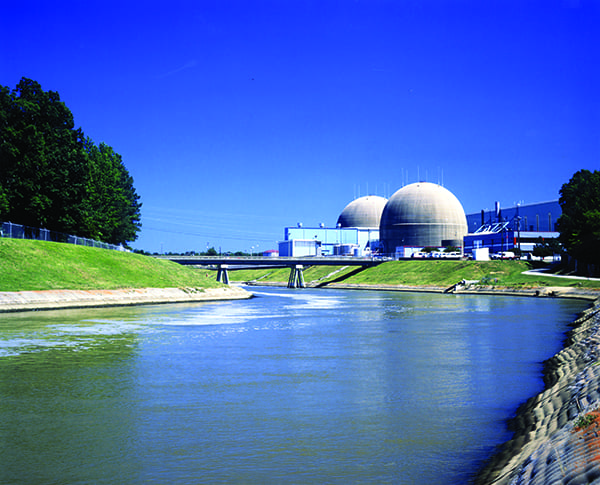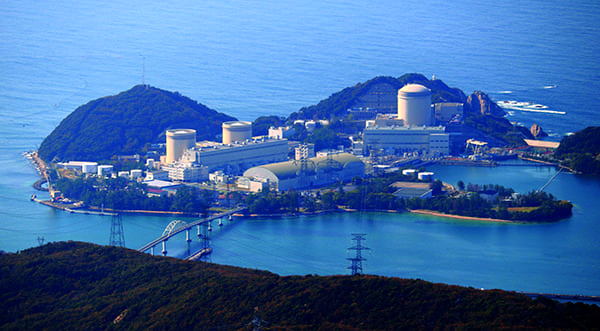Power plants that use steam to generate electricity need water. Without it, they can’t do their job. But water and steam are complicated, much as is blood in our veins and arteries. So, water chemistry is a big, complex and important job in steam-electric power plants.
Water is the lifeblood of all steam electric power plants—coal, combined cycle gas, or nuclear fueled. Literally.
On Dec. 9, 1986, a rupture in an elbow in the system that condenses cooling water at the Surry nuclear power plant (Figure 1) near Williamsburg, Virginia, killed four workers and cost tens of millions of dollars in lost revenues and repair costs. The cause, according to the Electric Power Research Institute (EPRI), was corrosion in a bend in the pipe from a feedwater pump. The pressurized water flashed to steam, scalding the workers and taking the plant out of service. Reuters reported at the time, “A similar accident at Surry about three years ago killed one worker and injured another.”
 |
|
1. Surry Units 1 and 2 are three-loop Westinghouse pressurized water reactors that began operation in December 1972 and May 1973, respectively. In October 2018, Dominion Energy filed an application to extend the operating licenses for the two units through 2052 and 2053—when they will be 80 years old. Source: U.S. Nuclear Regulatory Commission |
The Importance of Water Chemistry
“Lifeblood? I agree 100%,” Daniel Wells, program manager of EPRI’s nuclear sector water chemistry program, told POWER. The power industry’s chief research and development group has long had an active program for water chemistry in steam-electric power plants. The major generating technologies have common water concerns. Wells, a nuclear guru, said, “In general, water chemistry is one of the main ways we maintain material lifetime” in steam plants.
Alex Filar of Maryland-based Fossil Consulting Services Inc. also buys the “lifeblood” metaphor. In a company blog two years ago, he wrote, “At the heart of nearly ever[y] power plant are a boiler, a turbine, and associated condensate and feedwater systems. The water and steam coursing through them is the lifeblood of the electrical generating process. As such, it is of the utmost importance that the water/steam is properly monitored and treated. Poor water chemistry control can lead to deleterious effects on equipment uptime, plant budgets, and most importantly, personnel safety.”
The task for plant managers and operators is to control impurities and other characteristics in the water that transforms heat into steam and steam into electric power. Impurities can cause corrosion and cracking. Corrosion caused by oxidizing metal surfaces can release rust into the water stream and lead to deposits elsewhere in the plant’s innards.
That can also lead to deposits in the boiler, said Wells, reducing heat transfer and a slowing flow rate of water through the system. That means a less efficient plant and, as seen at the Surry plant, threats to worker safety.
Filar observed, “To better prevent these negative effects, water chemistry control has undergone substantial changes over the past 30 years. These changes have been the result of a commitment to research and technological development by the chemistry community. However, it is the power plant operator who is responsible for ensuring that these changes are implemented at their plant. And with an aging workforce in the industry, it is now more important than ever that the next generation of operators understand proper water chemistry control.”
EPRI’s Wells said operators need to concentrate on two major objectives: corrosion cracking, which can lead to pipe failure, and general corrosion, which can reduce heat transfer, lessen flow rate, and cause material degradation.
It’s Chemistry and Metallurgy
Writing in POWER a few years ago (see “Feedwater Chemistry Meets Stainless Steel, Copper, and Iron,” in the March 2015 issue), David Daniels, water chemistry specialist at M&M Engineering Associates Inc. of Leander, Texas, described three major metallurgies and their water chemistry challenges. “Alloys found in the condensate and feedwater systems of power plants include carbon steel for piping, pumps, and in some cases heat exchangers. Many systems still have some copper-based alloys from admiralty brass and copper-nickel (Cu-Ni) alloys all the way to 400 Series Monel, primarily as feedwater heater tubes.”
Stainless steel alloys generally avoid the common corrosion mechanisms that afflict carbon steel and copper alloys. That’s because stainless “is protected by a tight adherent chromium oxide layer that forms on the surface,” Daniels wrote.
“There is the tendency to think that stainless steel is the perfect alloy to replace copper-alloy feedwater tubes,” said Daniels. But the Achilles’ heel of stainless is that chlorides and corrosive caustics can lead to stress corrosion cracking. Intergranular stress corrosion cracking was a major issue in nuclear plants in the 1980s, although EPRI-led research has largely offered ways to manage that problem.
Flow-Accelerated CorrosionFlow-accelerated corrosion (FAC) is one of the trickiest water chemistry challenges. According to U.S. Water, “Few subjects have captured the attention of boiler cycle chemistry experts and research dollars in the past 10+ years as flow-accelerated corrosion. Having previously been most concerned about failures occurring in higher pressure areas of the cycle, FAC is now a primary concern as more than 60% of all utilities have reported finding it in their facilities. Defined as localized rapid metal loss resulting in tube wall thinning of carbon and low alloy piping, FAC is known to occur in the mid-temperature regions of the cycle, between 250F and 400F. In high pressure boiler cycles, these temperatures exist in boiler feedwater or ‘LP’ (low pressure) and ‘IP’ (intermediate pressure) sections of a Heat Recovery Steam Generator (HRSG).” EPRI has been studying FAC for many years. Its updated 2017 guidance for control of FAC, Guidelines for Controlling Flow-Accelerated Corrosion in Fossil and Combined Cycle Plants, says, “FAC causes localized wall thinning (metal loss) in carbon steel piping, tubing and vessels exposed to flowing water (single-phase) or wet steam (two-phase). If undetected, the degraded component can suddenly rupture, releasing high temperature steam and water into neighboring plant areas and this often includes locations where personnel may be present. The escaping fluids can injure plant workers, sometimes resulting in fatalities, and damage nearby equipment. Over the years, FAC has caused hundreds of piping and equipment failures in all types of fossil, industrial steam, and nuclear power plants, as well as tube failures in HRSGs.” The 1986 Surry pipe rupture and fatalities drew attention to the problem. “Prior to the mid1980s,” says EPRI, “the cause of these failures was often not known by the plant owner, or if known, was not reported. Additionally, the power industry did not fully understand the conditions under which FAC occurred, where plants should look to find it, or how to best control it when it was found.” This changed following the Surry pipe rupture. “FAC was found to be the cause of the failure. Because deaths occurred, and because of the high regulatory standards applied to nuclear power plants, a comprehensive overall approach was needed.” By the late 1980s, FAC started showing up “in conventional fossil plant feedwater systems, and inspection programs were initiated. This initiative took on fresh emphasis following a fatal pipe rupture at the Pleasant Prairie Plant in 1995,” EPRI says. In that incident at the 1,200-MW coal-fired plant in Wisconsin, a steam pipe break killed one worker and critically injured another. The local newspaper reported, “A 400- to 600-degree column of steam soared to the top of the 20-story plant, trapping Steven Baker and Gregory Schultz in a lethally hot cloud.” Says EPRI, “Unfortunately, the efforts in the nuclear and conventional fossil plants have not eliminated fatal FAC failures.” In 2004, five employees were killed due to a FAC-caused pipe rupture at Mihama Unit 3 in Japan (Figure 2), and in 2007, two FAC-related fatalities and one serious injury occurred at the coal-fired Iatan power station in the U.S. due to a catastrophic rupture of a steam line.
|
For carbon steel and copper alloys, according to Daniels, the major corrosion mechanisms include flow-accelerated corrosion (see sidebar) and corrosion fatigue in carbon steel as well as ammonia-induced stress corrosion cracking and ammonia grooving in copper alloys.
Nuclear Power Water Chemistry
While water chemistry is crucial for all steam-electric plants, noted EPRI’s Wells, nuclear plants have some unique problems. That stems from the fact conventional light-water reactors have water that touches the fuel, meaning the H2O carries radiation. That complicates maintenance activities and potentially exposes workers to contamination.
Radiation can also cause degradation of the metals in the plant, and its water and steam circulation. That has implications for life-extension of nuclear plants, which the industry sees as crucial to its future. “When we look at long-term operations, water chemistry is certainly something that contributes” to the analysis, Wells said.
Water Chemistry Challenges Ahead
Advanced nuclear designs will also bring water chemistry challenges, Wells said, noting NuScale Power’s proposal for a small modular reactor. EPRI, he said, is looking closely at the NuScale reactor design, including the implications for water chemistry.
Another future challenge, according to Wells, is “the availability of chemicals.” Lithium hydroxide (isotopically enriched in lithium-7) is used to alkalize the reactor coolant in pressurized water reactors for corrosion control. Its supply could be threatened, so EPRI has developed a way to use boric acid to get lithium-7 from boron-10. That, he said, “is sitting on the shelf.”
Another possibility is use of potassium hydroxide (KOH) as a substitute. The Russians use KOH in their VVER pressurized water reactors for the same purpose U.S. owners use lithium hydroxide—to keep the water alkaline preventing corrosion. EPRI, Wells said, “has spun up a large effort to complete technical work to transfer over to potassium hydroxide.” A demonstration is likely in 2020 or 2021.
Another chemical challenge is the use of hydrazine (N2H4). Operators of both fossil and nuclear power plants use it in the steam cycle to reduce dissolved oxygen and corrosion. But it’s a nasty chemical in several ways and banned in Europe for causing cancer. “Our plants are concerned that they might not be able to use it” in the future, Wells said. “The Europeans have done some work on a replacement chemical and EPRI’s role is as a collaborative engine to pull all the research together,” he said. ■
—Kennedy Maize is a long-time energy journalist and a frequent contributor to POWER.
https://www.powermag.com/water-chemistry-power-plant-life-and-death/?pagenum=3
